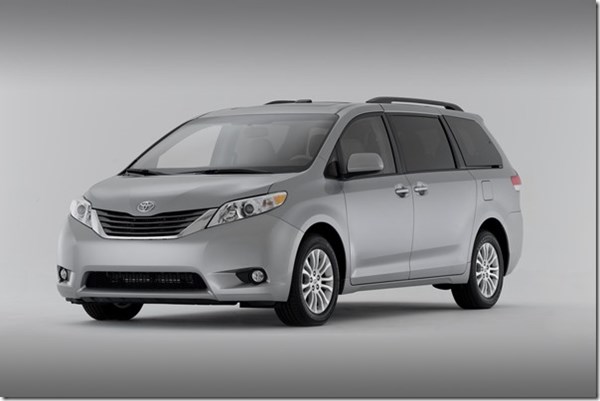2014 Toyota Sienna XLE 3.5 L
A basic tenant of Toyota is kaizen, or continuous improvement, and this is certainly reflected in its minivan offerings.
#interior
A basic tenant of Toyota is kaizen, or continuous improvement, and this is certainly reflected in its minivan offerings.
Consider this: Toyota’s first foray into the segment in the U.S. market was with a model year 1984 vehicle named, simply, “Van.”
If nothing else, the name Sienna, which first appeared on model year 1998 minivans (a variant on the name of the Italian city Siena), is quite an improvement over Van.

What’s interesting to note is that when Toyota launched the Van, Chrysler launched its minivans. And in subsequent years General Motors and Ford both entered and exited the segment, and Honda got in and stayed. Nissan is there, as is Kia, but the penetration of the former is small and the latter smaller. Which is to say that it is pretty much a three-way contest.
Toyota replaced the Van with the 1990 Previa, a futuristic-looking minivan that had its run until the more conventional ’98 Sienna replaced it. The Previa had a mid-engine configuration and was a rear-drive vehicle (also available as AWD). The first-generation Sienna was seriously in the minivan space, boasting features like 14 cupholders, the sort of thing that all minivans were measured by. (Another metric was a sheet of plywood, as though all minivan owners were heavily into DIY The second-generation Sienna, model year 2004, was launched in 2003. That vehicle had its run until the model year 2011 third-generation Sienna appeared. That is the model the 2014 is based on.

In the years that Toyota has been offering a minivan, it has garnered awards from organizations ranging from AutoPacific to Good Housekeeping, from J.D. Power to Parent’s Magazine. There are probably so many trophies that the capacious capacity of the Sienna would be insufficient to accommodate all of them. In addition to which, there was a recognition that even though there are Japan-domestic model minivans (e.g., the original Van was known as the “MasterAce” in Japan), the American market is particular when it comes to minivans. When the second-generation Sienna was launched it came with more than 90% of its content from North American suppliers.
The Sienna driven here is built in Princeton, Indiana. The V6 engine comes from Buffalo, West Virginia, as does the six-speed automatic transmission. (Speaking of the engines: from the start, Siennas have always been offered with a V6; now the 266-hp V6 is the only offering, as the four-cylinder version, available only for a couple years in the third-generation configuration, was discontinued.)
Here’s the thing. No matter how good the Sienna is, no matter how comfortable, no matter how capacious, no matter how clever, no matter how efficient, no matter how well put together, no matter how well designed. . .if you don’t like minivans, none of that matters. The stigma of the body style remains strong. There it is, a vehicle capable of accommodating seven, a vehicle that has all-wheel-drive so that there was a sense of safety on the winter roads in southeastern Michigan, a vehicle with comfortable accommodations including a comprehensive set of HVAC controls for those who are not in the front seat, a vehicle that drives like a sedan not a truck (because modern minivans are more like sedans than trucks, given their unibody construction, not frame rails below), and yet those I encountered tended to be staunchly against minivans.

Think about it: is there any type of vehicle that you can think of people being strongly opposed to? The only thing that I can come up with is the Hummer that was derided by environmentalists as being a gargantuan Swarzeneggerian gas-guzzler. But coupes, convertibles, crossovers—is there any voiced resistance to them?
I suppose the thing is this: My interest in the Sienna was predicated on the need to haul several family members. That, in effect, made me not a driver, per se, but functionally a chauffeur. And there, I think, is the real problem with the minivan. Even though the soccer parents who haul their kids in a large, difficult-to-park crossover are serving the same service, it is because it is in a vehicle that is not directly associated with utility (even though that’s the central term in CUV) that it is OK.
For those who are pro-minivan, the Sienna XLE has the goods in terms of creature comfort, the quality that is associated with Toyota and the capacity that one looks for in a minivan.
For those who are opposed: you probably don’t want to know what you’re missing, because you’re missing a lot.
Selected specs
Engine: 3.5-liter, DOHC V6
Horsepower: 266 @ 6,200 rpm
Torque: 245 lb-ft @ 4,700 rpm
Material: Aluminum block and heads
Transmission: Six-speed automatic
Steering: Electric power-assisted rack-and-pinion
Wheelbase: 119.3 in.
Length: 200.2 in.
Width: 78.2 in.
Height: 68.9 in.
Passenger volume: 164.4 cu. ft.
Cargo volume: 39.1 cu. ft. (behind third row); 150 cu. ft. (w/second row removed)
Fuel economy: 16 mpg city/23 mpg highway/19 mpg combined
RELATED CONTENT
-
Jeeps Modified for Moab
On Easter morning in Moab, Utah, when the population of that exceedingly-hard-to-get-to town in one of the most beautiful settings on Earth has more than doubled, some people won’t be hunting for Easter eggs, but will be trying to get a good look at one of the vehicles six that Jeep has prepared for real-life, fast-feedback from the assembled at the annual Easter Jeep Safari.
-
About the 2019 Toyota RAV4
Last year Buick sold 219,231 vehicles in the U.S.
-
2019 Mazda3 Sedan Premium FWD
As Mazda pivots to “premium,” it is doing more than just talking about it, as the new Mazda3 proves.


.jpg;width=70;height=70;mode=crop)